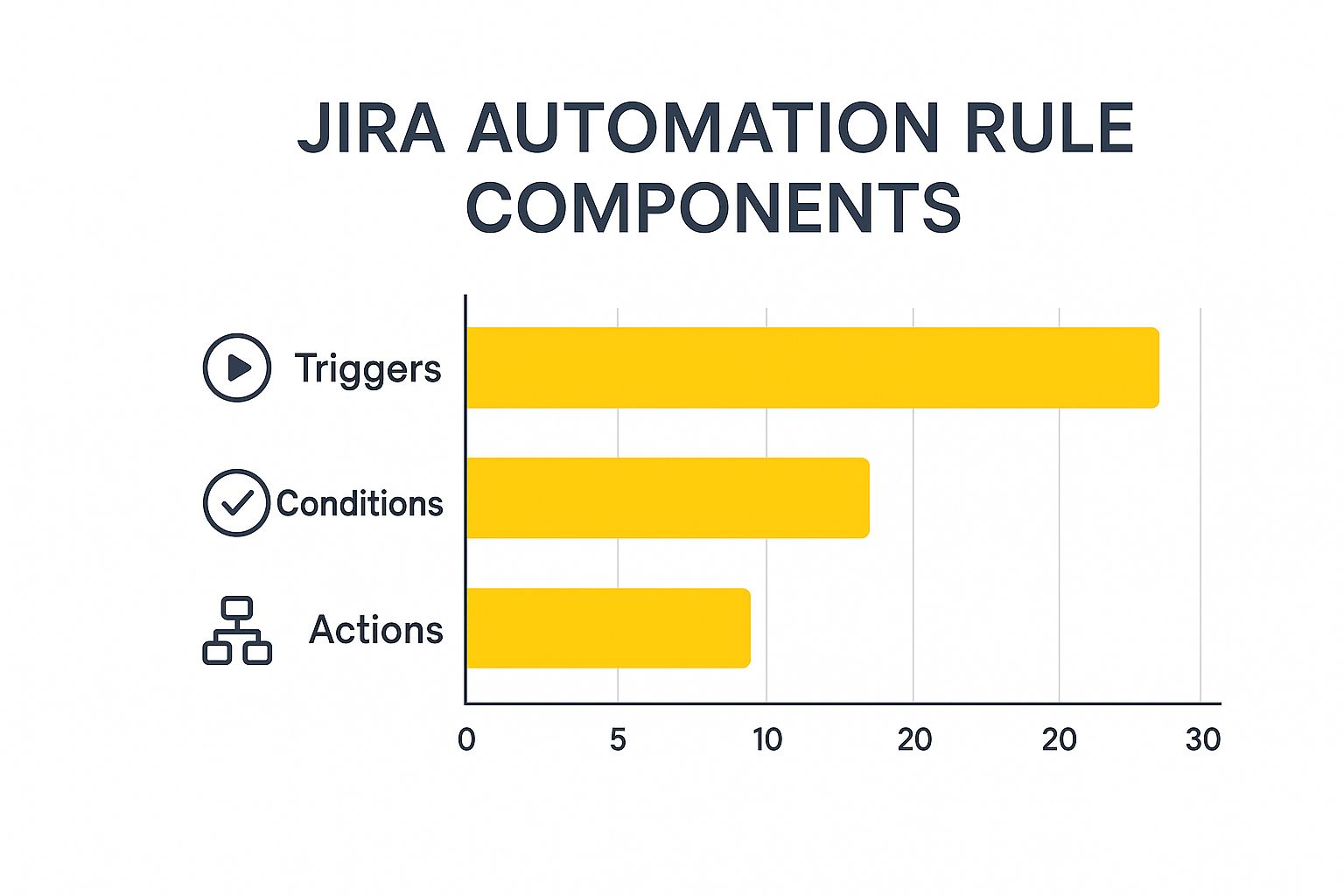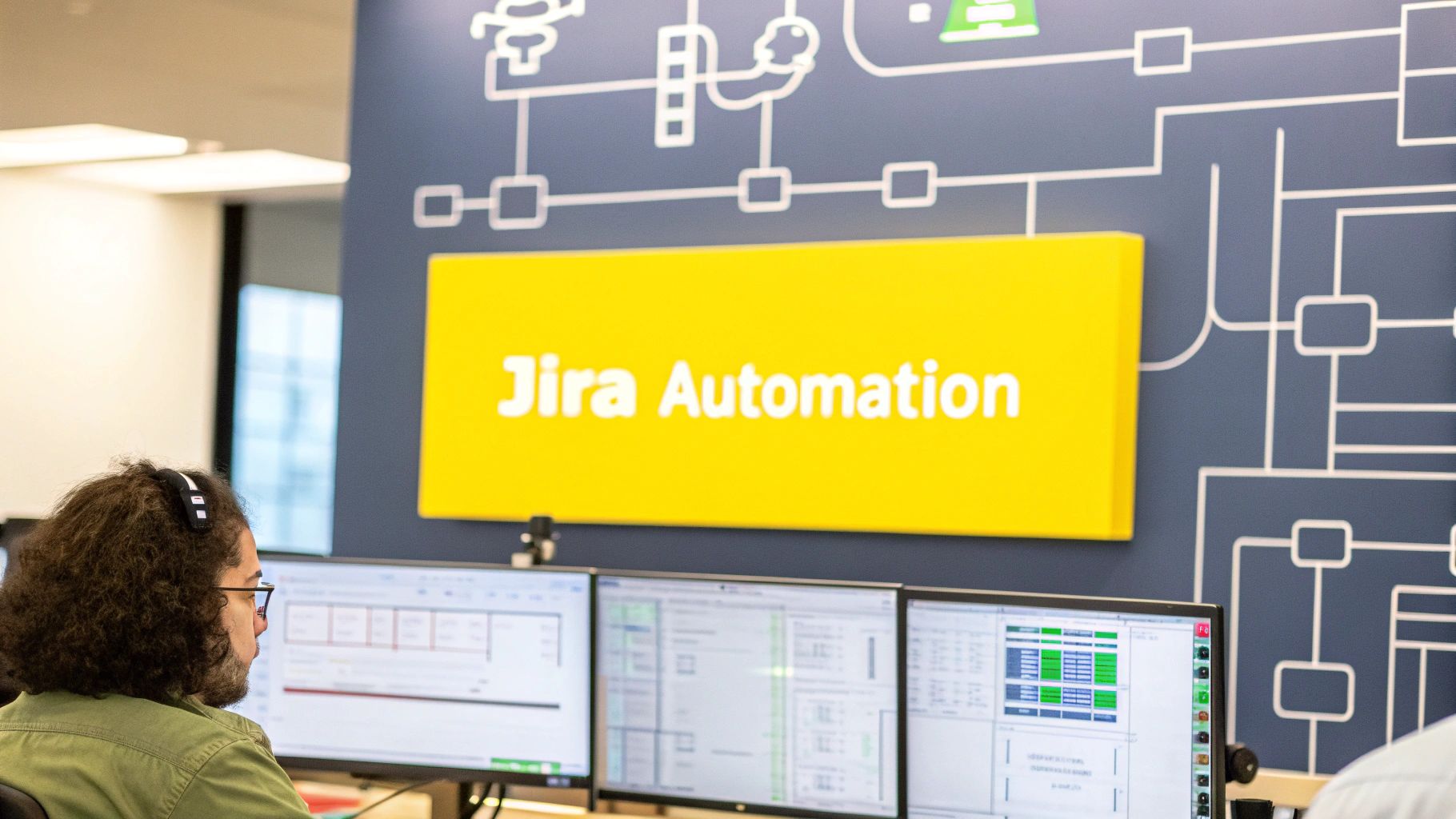Breaking Down Jira Automation Rules: The Essentials
Jira automation rules are key for teams wanting to ditch manual workflows and boost productivity. Leading organizations use these rules to save significant time, often hundreds of hours monthly. These rules let teams automate repetitive tasks, freeing them up for more important work. Let’s look at the core components that make this possible.
Triggers: The Starting Point
Every automation rule starts with a trigger. This event kicks off the whole process. Think of it as the first domino in a chain reaction. Triggers can be anything from creating or updating an issue to a specific date and time.
For example, a trigger might activate when a bug report is assigned to a developer. This initial action starts the subsequent steps in the automation rule.
Conditions: Adding Precision
Triggers start the automation, but conditions provide crucial control. They determine if the following actions happen based on specific criteria. Conditions act like filters, making sure your automation only applies in relevant situations.
This allows you to create targeted rules that run only when necessary. For example, you could add a condition to our bug report scenario so the automation only runs if the bug is marked “high priority.”
Actions: The Heavy Lifting
Actions are the core operations performed by the automation rule. This is where the real work happens. Actions can be simple, like assigning issues and sending notifications. Or they can be complex, like moving issues through different workflow stages.
In our bug report example, the action could be to automatically notify the QA team when the developer marks the bug “resolved.”
Managing Jira Automation Usage
The flexibility of Jira automation rules requires responsible management. Since November 2023, Atlassian has introduced usage limits on free automation executions in Jira. This is a crucial factor for organizations relying on automated workflows. Each Jira instance has a limit on free executions. After this limit, rules stop working until the next billing period. It’s important to understand these limits and learn best practices for managing your automation usage. Learn more about usage limits for Jira automation rules
This combination of triggers, conditions, and actions provides a powerful and accessible way to automate even complex processes in Jira. Understanding these building blocks empowers teams to create a responsive system adapted to their specific needs.
Building Your First Jira Automation Rules That Actually Work

So, you’re ready to ditch manual Jira issue updates and embrace the power of automation? Great! This section will guide you through creating your first effective Jira automation rules. We’ll explore core concepts and provide practical examples you can use right away.
Navigating the Automation Builder
The Jira automation builder is your command center. This user-friendly interface lets you create, manage, and track all your automation rules. It provides a visual method for connecting triggers, conditions, and actions—the fundamental components of any automation rule.
Think of it as a virtual LEGO kit for your workflows. You simply drag and drop components, linking them to define the exact behavior you need.
Selecting the Right Triggers
Choosing the correct trigger is essential. The trigger is the event that kicks off your automation. Common triggers include issue creation, updates, transitions, and comments.
The right trigger depends on the workflow you’re automating. For instance, if you’re automating bug assignments, the “Issue Created” trigger is an ideal starting point.
Crafting Precise Conditions
Conditions add a layer of control, ensuring your automation rules only run under specific circumstances. They act as gatekeepers, only allowing the automation to proceed if certain criteria are met.
For example, you might configure an automation rule to trigger only if an issue is labeled “High Priority” and assigned to a specific team. This precision prevents unintended consequences.
Building Action Sequences
Actions form the core of your Jira automation rules. They define what actually occurs when a trigger fires and the conditions are satisfied. Actions can range from simple notifications to complex, multi-step processes.
You can link several actions together to create sophisticated automated workflows. This could involve automatically transitioning an issue, assigning it to the correct team member, and then adding a comment.
Troubleshooting and Validation
Creating effective automation rules sometimes requires troubleshooting. Luckily, Jira offers tools to help pinpoint and resolve issues. Logging and error reporting offer valuable clues about why a rule isn’t working correctly.
Atlassian also introduced helpful validation features in early 2025 to improve rule accuracy and minimize errors. These features allow you to check your rules for potential issues before activating them, saving you troubleshooting time down the line. Learn more about these enhancements to build error-free rules from the get-go. Explore this topic further.
By following these steps, your initial automation efforts will bring tangible benefits, not headaches. Remember to regularly test and refine your rules as your team’s processes change.
Next-Level Jira Automation Rules for Complex Workflows
Building upon the fundamentals of Jira automation rules, you can create intricate workflows that significantly improve your team’s efficiency. High-performing teams use advanced techniques to automate even their most complex processes. This section explores these strategies, showing you how to elevate your Jira automation.
Advanced Triggering Mechanisms
Jira offers powerful options beyond basic triggers for initiating automations. Scheduled triggers enable rules to run at specific times, ideal for routine tasks like report generation or cleaning up outdated issues. Webhook integrations connect Jira to external events, allowing automations to respond to changes in other systems. For instance, a webhook could trigger a Jira automation when a code commit happens in your GitHub repository. Multi-component triggers, combining multiple conditions, provide fine-grained control, allowing your automations to respond to complex scenarios.
Precision Targeting With Conditions and Branching
Refine your automation rules by mastering advanced conditions and branching logic. Using “AND” and “OR” operators to combine multiple conditions creates highly specific criteria for triggering actions. Branching logic lets your automation follow different paths based on these conditions, ensuring the appropriate action every time and streamlining decision-making.
Building Maintainable Automation Architectures
As your automation ecosystem expands, maintainability becomes essential. Using modular design principles, like in software development, allows you to create reusable automation components. Consistent naming conventions make rules easier to understand and modify. Thorough documentation ensures your automations remain valuable as teams and processes change.
Strategic Rule Chaining
For complex multi-step processes, consider rule chaining. This technique lets one automation trigger another, creating sophisticated sequences that would be impossible to manage manually. As you develop complex workflows, consider advanced techniques like scheduled automation for creating an automated blogging system, a valuable resource for teams and individuals. In 2024, Atlassian advanced Jira Automation with AI-powered features and streamlined workflows, including an AI-driven natural language interface for rule creation. Learn more about these advancements here.
The following infographic shows the core building blocks in Jira for creating automation rules:

This infographic highlights the variety of components, with 30 triggers, 20 conditions, and 25 actions, offering exceptional flexibility for designing automated workflows. This wide array ensures almost any workflow can be automated, boosting efficiency.
To help you understand how different triggers can be used, let’s look at the following table.
Common Jira Automation Triggers and Their Use Cases: A comprehensive comparison of different automation triggers in Jira and when to use each for maximum effectiveness
| Trigger Type | Description | Best Use Cases | Limitations |
|---|---|---|---|
| Scheduled | Triggers automation at specified times/intervals | Generating reports, cleaning up old issues, recurring tasks | Not suitable for real-time responses |
| Webhook | Triggers based on external events from other systems | Integrating with code repositories, build tools, monitoring systems | Requires configuration of external systems |
| Issue Created | Triggers when a new issue is created | Automatically assigning issues, setting due dates, adding labels | Not applicable for existing issues |
| Issue Updated | Triggers when an issue is modified | Tracking progress, notifying stakeholders, updating linked issues | Can be triggered by minor changes, potentially leading to unnecessary automation runs |
| Issue Commented | Triggers when a comment is added to an issue | Facilitating discussions, escalating issues, triggering reviews | May not be appropriate for all workflows |
| Issue Transitioned | Triggers when an issue moves to a different status | Automating workflows, updating fields, sending notifications | Limited to specific transitions |
| Multi-component Trigger | Combines multiple conditions for complex scenarios | Automating approval processes, managing dependencies, enforcing business rules | Requires careful planning and configuration |
This table summarizes the key triggers available in Jira, highlighting their strengths and weaknesses. By understanding these nuances, you can choose the right trigger for your specific automation needs. Choosing the correct trigger is the first step in building effective automations within Jira.
Maximizing Performance of Your Jira Automation Rules
Is your Jira instance feeling a bit slow? Your automation rules might be the reason. This section offers practical tips for creating fast and efficient automations that won’t bog down your system.
Identifying Performance Bottlenecks
Effective Jira administrators are proactive about identifying performance issues. They examine execution statistics and logs to find slow or resource-intensive rules. This data provides valuable clues about which automations need to be optimized. For instance, a frequently running rule with complex conditions might be a good candidate for improvement.
Streamlining Rule Execution
After pinpointing potential bottlenecks, you can begin optimizing. One key technique involves refining triggers and conditions. More specific triggers guarantee that the rule only runs when absolutely necessary. Well-defined conditions minimize unnecessary processing. This ensures the automation only executes when specific criteria are met, conserving processing power. Using Jira automation rules helps eliminate manual tasks. For example, you can automate project data entry and reporting, moving away from manual spreadsheet management. You could even Stop Using Spreadsheets To Track Your Portfolio entirely.
Implementing Governance Frameworks
Balancing automation access with performance is essential. A solid governance framework empowers teams to create automations while preventing uncontrolled growth. This could include guidelines for creating rules, naming conventions, and documentation standards. Such a framework helps avoid automation sprawl, where redundant rules compete for resources and impact overall performance. A clear framework promotes a healthy and efficient automation ecosystem.
Conducting Regular Automation Audits
Regular audits are key for maintaining a high-performing automation environment. During an audit, examine existing rules for redundancies or outdated automations. This helps consolidate similar rules and remove unnecessary ones. Consistent audits keep your automation system lean and responsive, ensuring it adapts as your organization changes.

These proactive strategies will keep your Jira running smoothly. Consider these audits as routine maintenance for your automation engine, keeping it tuned for optimal performance.
Connecting Your World With Jira Automation Rules

Effective automation extends beyond individual tasks within Jira. Leading organizations use Jira automation rules to connect workflows across their entire tech stack. This creates a connected ecosystem, improving collaboration and information flow. Let’s explore how to build these integrated workflows.
Integrating With Other Atlassian Products
Connecting Jira with other Atlassian tools creates a powerful, unified work experience. Seamless integrations with Confluence, Bitbucket, and Statuspage, for instance, streamline workflows and centralize key information.
Imagine automatically updating a Confluence page with Jira project statuses. Or triggering a Bitbucket build after a Jira issue moves to “Ready for Development.” These types of integrations offer a single source of truth for your team.
Extending Automation With Webhooks and APIs
Beyond the Atlassian ecosystem, webhooks and REST API connections broaden automation possibilities. Webhooks act like real-time messengers, sending Jira notifications about external system events. This allows Jira automation rules to respond to changes in tools like GitHub or Slack.
REST APIs, conversely, enable direct communication between Jira and other applications. This allows you to retrieve data and trigger actions, creating powerful, customized integrations.
Leveraging Third-Party Integration Platforms
For those without coding experience, third-party integration platforms provide user-friendly ways to connect Jira with other tools. These platforms typically include pre-built connectors and visual workflow builders, minimizing the need for custom code. This empowers teams to integrate Jira with their preferred tools, regardless of technical expertise.
To illustrate the power of these integration options, let’s look at a comparison of their capabilities:
To help you choose the right approach, here’s a comparison of different Jira integration methods:
Jira Automation Integration Options
| Integration Method | Setup Complexity | Capabilities | Best For | Limitations |
|---|---|---|---|---|
| Atlassian Product Integrations | Easy | Seamless data synchronization within the Atlassian ecosystem | Teams heavily reliant on Atlassian tools | Limited to Atlassian products |
| Webhooks | Moderate | Real-time event notifications | Triggering actions in Jira based on external events | One-way communication (external system to Jira) |
| REST APIs | Complex | Bi-directional data exchange and action triggering | Custom integrations and complex workflows | Requires coding experience |
| Third-Party Platforms | Easy to Moderate | Visual workflow building and pre-built connectors | Non-developers and simpler integrations | May have limited customization options |
This table provides a concise overview of the various integration methods, helping you determine the best approach for your team’s needs. Consider your technical capabilities and the complexity of your desired integration when making your decision.
Real-World Integration Examples
Here are some ways teams use Jira automation rules for integrated workflows:
- Development Teams: Automatically create Jira bugs from GitHub issue reports or update Slack channels with deployment statuses.
- IT Service Teams: Integrate Jira Service Management with monitoring tools to automatically create incidents or send alerts to on-call staff.
- Marketing Teams: Use Jira automation rules to track campaign progress across different platforms and trigger notifications based on key performance metrics.
Security Considerations for Cross-System Automations
While integrations are powerful, security is paramount. Ensure robust authentication and authorization mechanisms when connecting Jira with other systems. Use secure data transmission methods like HTTPS for webhooks and API calls. Regularly review access permissions and limit access to sensitive information. Protecting your data while building powerful workflow connections is essential. Implementing these security best practices allows you to securely connect systems while safeguarding valuable information.
By considering these approaches and examples, you can effectively use Jira automation rules to connect your tools and teams, creating a more efficient and collaborative work environment. This interconnectedness empowers teams to achieve more, seamlessly transitioning between platforms and streamlining information sharing.
Jira Automation Rules That Transform Real Teams
Let’s move past the theoretical and explore how real-world teams are using Jira automation rules to achieve measurable improvements. Examining these practical examples provides adaptable models you can tailor to your specific team needs. This hands-on approach helps visualize automation’s direct impact on various team workflows.
Development Team Automation
Development teams often leverage Jira automation to optimize their workflows. A common example is automating the code review process. When a developer marks a task as “Ready for Review,” a rule can automatically assign reviewers. This eliminates the manual assignment step, accelerating feedback cycles.
Another frequent use case is automating release processes. By connecting Jira to their build and deployment tools, such as Jenkins, development teams can manage complex releases with minimal manual effort.
Furthermore, automation strengthens feedback loops. Rules can automatically generate Jira tickets for bugs identified through other systems. This helps ensure no bug report is overlooked, ultimately enhancing software quality. These automated processes free up developers to concentrate on building exceptional software.
IT Service Team Automation
Jira automation rules significantly benefit IT service teams, especially in incident response. Automated triage can intelligently route incoming incidents to the appropriate support group based on keywords or categories. This ensures rapid responses and shorter resolution times.
Automated problem management workflows flag recurring incidents for investigation, preventing future disruptions. Automation also facilitates effective change control systems. Automated approvals and notifications ensure compliance with company policies without adding unnecessary administrative overhead.
These automation examples showcase how IT service teams can significantly improve their operations, increasing efficiency and minimizing service interruptions. This allows teams to prioritize proactive support and problem-solving.
Marketing Team Automation
Marketing teams also utilize Jira automation to streamline their campaigns and projects. Many automate the tracking of campaign progress. Rules can automatically update Jira issues with relevant metrics from other marketing platforms like HubSpot or Marketo, creating a central hub for performance monitoring.
Automating creative approvals simplifies the review process. Rules can route marketing materials to the appropriate stakeholders, reducing delays and ensuring timely delivery. Automating resource allocation also leads to improvements. Rules can automatically assign tasks based on team member availability and skill set, optimizing resource utilization across various initiatives.
These automation examples highlight how marketing teams can gain more control, improving efficiency and maximizing their impact. By automating routine tasks, marketing teams can focus on strategic planning and creative development.
By exploring these practical applications, we see how Jira automation rules can be impactful across different teams. Each example offers inspiration and practical guidance that you can customize for your team. This allows teams to apply these successful automation strategies within their own workflows.
Ready to improve your team’s workflow and experience the advantages of automation? resolution’s NASA – Not Another Standup App seamlessly integrates with Jira to improve structure, clarity, and collaboration during team meetings. Learn more about NASA and how it can improve your team’s meetings.
